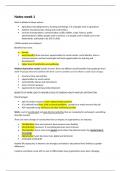Notes week 1
Work is divided in three sectors:
Agriculture (including forestry, hunting and fishing), 1/3 of people work in agriculture
industry (manufacturing, mining and construction)
services (transportation, communication, public utilities, trade, finance, public
administration) 2 billion people work in services, 1/6 people work in health care in the
Netherlands, estimated to be 25% in 2030
4 billion people are employed
Benefits from work:
Income
social benefits (time structure, opportunities for social contact, social identity, share a
common purpose and feel meaningful and lastly opportunities for learning and
development)
higher level of satisfaction and wellbeing.
Relative deprivation model: besides income, there are different social benefits that people get from
work people who feel satisfied with their current condition are less likely to seek social change:
structure (time and activity)
opportunities for social contact
social identity (status and self-esteem)
share common purpose
opportunity for learning and development
BENEFITS OF WORK LEAD TO HIGHER LEVELS OF GENERAL HEALTH AND LIFE SATISFACTION
Disadvantages:
10% of workers reported work-related health problems
6 % suffered from bone, joint or muscle problems, caused by or made worse by the job
45% reported facing risk factors for their well-being at work
Work: a set of coordinated and goal-directed activities that are conducted in exchange to something
else (like money).
There are many changes in society that have an impact on organizations, for instance:
Flexibilization (time and contracts have become more flexible)
Intensification (pressure everything becomes more intense)
Mentalization (turns more into mental work rather than physical work, the mental load is
increasing)
Digitalization (work becomes more digital and technical)
prolonged working life
Healthy life expectancy is known to be strongly correlated to educational level (without a gender
difference).
Cameron and Quinn came with an axis to differentiate how organizations have been changing.
,The first axis is the dimension between control and flexibility in terms of processes within an
organization. The second axis (horizontal) is about internal and external orientation. More externally
orientated organizations are usually more focused on productivity and competing in the world
outside of the company than more internally focused organizations.
Organizations that do not change, will not survive!
This gives the following four models above.
The core question for psychology in the work field is “how can work and organizational psychology
help people to work in a motivated, productive, and healthy way during their entire working life?”
1. Work and health psychology fit between job and a person: focusses on how work, work
conditions and work and resting times be structured to guarantee work quality and good
health, and to optimize performance. Important concepts are job design, fatigue, stress,
motivation, and sickness absence.
2. Organizational psychology is about how organizations and business processes should be
structured to make people collaborate as efficiently and effectively as possible. Important
concepts are organizational structure & culture, leadership, organizational change and
dealing with resistance.
3. Personnel psychology / HRM is about how we can ensure an optimal person-job fit and flow
of people through and organization, in which individual capacities and desires continue to
match work demands and opportunities within the organization. Important concepts are
recruitment & selection, development of competences, performance appraisal and reward
systems like money.
Scientific management (Taylorism) is a model for having an efficient organization which assumes
that there is one best way to do something, that workers are stupid, that money is the only
motivator, and that managerial control is necessary to gain more profit. They thus have pay based
on performance. *shovels*
It has the following four principles:
, 1. The scientific approach: time & motion studies.
2. Selection and recruiting of the best person for a job
3. Training and development of worker
4. Separation between thinking and physical work
It resulted in a rise of productivity and profit; workers revolted.
Taylorism (another name for the method) is still used on this day.
Ford in his motor company used different men for each motor part making it a lot of times more
efficient than just one man making the car. It’s known as the first assembly line. Unions were
however not allowed, and this caused incidents.
Battle of the overpass: union reps were beat up by Ford officials
Yerkes is a man who made army intelligence tests in the first world war which were known to
diagnose more people with being mentally 10-12.
After WW2 there was a growth of selection psychology and a broadening organizational psychology.
There was more focus on learning & training, leadership, fatigue & stress, and safety & ergonomics
(study of people’s efficiency in their working environment).
In the 60’s there was a wave of democratization, criticism of selection psychology and an opposition
of labor unions.
From the 70’s onwards there was more differentiation, broadening and scientific deepening of work
and organizational psychology.
The self-determination theory states that people are motivated to develop and change by three
universal and psychological needs. People can be self-determined when their needs for autonomy
(zelfbestuur), competence and relatedness / connectiveness are met.
Questions now are about whether people still autonomy have when an algorithm makes decisions or
workers feel less competent due to these types of things or about whether people feel connected
when working from home.
Work and health analysis is the systematic collection and assessment of data to form a judgement
about the nature of a task/job/profession and the work-related health of the employee.
The x model of work states that the person and the work situation both contribute to work behavior
which affects work performance and personal outcomes. It consists of five interacting blocks.





